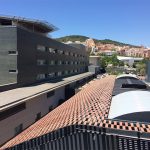
The Sant Pau Biomedical Research Institute (IIB Sant Pau) with the Lipids and Cardiovascular Pathology Research Group, led by Dr. Vicenta Llorente-Cortes, organized the seminar “elastan modification during vascular aging and pathophysiological consequences” by Prof. Laurent Duca, from the University of Reims Champagne-Ardenne. The conference will take place on 11 December at 3 p.m. in the multipurpose rooms.

Researchers at CIBER Cardiovascular Diseases (CIBERCV), including members of the Research Group Regulatory Mechanisms of Cardiovascular Remodeling at the Research Institute of the Hospital de la Santa Creu i Sant Pau – IIB Sant Pau, have made progress in identifying the involvement of the connective protein 43 (Cx43) that could be key to understanding the mechanisms by which cardiac fibrosis occurs, as they are currently not fully known and there are no effective therapies to reverse it.
In a research published in the journal Cells, led by Antonio Rodríguez Sinovas of the Vall d’Hebron Research Institute in Barcelona, and in which the group of Ph. José Martínez González from the Consejo Superior de Investigaciones Científicas and researchers from the Grupo de Investigación mecanismos Reguladores del Remodelado Cardiovascular del Instituto de Investigación del Hospital de la Santa Creu i Sant Pau – IIB Sant Pau, all of them belonging to the ‘CIBERCV, have studied the mechanisms through which this protein regulates the appearance of fibrosis after pressure overload using a murine transgenic model.
The connections are a family of membrane proteins with a characteristic structure, which form intercellular channels that contact the cytoplasms of neighbouring cells. In the heart, they form plates called “gap junctions” that constitute low resistance pathways that are essential to allow the flow of electric current between the cells. Cx43 is widely distributed in most tissues, including cardiac cells (cardiomyocytes, fibroblasts, endothelial and smooth muscle cells).
Pressure overload leads rapidly to hypertrophy, cell death and fibrosis.
During a pressure overload, such as that occurring in patients with hypertension or obstruction of the left ventricular outflow tract, there is increased resistance to blood leaving the heart. This leads, as a compensatory mechanism, to the development of cardiac dilatation and hypertrophy. But although cardiac hypertrophy is initially an adaptive process necessary to maintain cardiac output, it rapidly progresses to a pathological situation, resulting in cardiac cell death and fibrosis. The appearance of fibrosis is especially relevant, as it reduces contractility and causes diastolic dysfunction.
“Cx43 is an essential protein in cardiac function. It plays a key role in the propagation of the electrical impulse, and therefore in the appearance of ventricular arrhythmias”, says CIBERCV researcher Antonio Rodríguez Sinovas, responsible for this work, who explains that “in addition, it participates in the extension of myocardial damage by ischemia-reperfusion during myocardial infarction”. He adds that “until now there were contradictory data on its possible influence on cardiac scarring. Our work has shown that modulating Cx43 expression is associated with changes in collagen deposition after treatment with angiotensin II. Thus, a marked reduction in Cx43 expression causes a decrease in collagen accumulation with respect to its control group, thus improving ventricular remodeling. These data suggest, therefore, that this protein would be involved in the process of cardiac scarring.
Furthermore, using molecular and cellular biology techniques, the authors have been able to determine that Cx43 can exert its effects on cardiac scarring by modulating the activity of metalloproteins, as well as the inflammatory response and the activity of fibroblasts.
Link to the reference article:
Opposite Effects of Moderate and Extreme Cx43 Deficiency in Conditional Cx43-Deficient Mice on Angiotensin II-Induced Cardiac Fibrosi
Valls-Lacalle, Negre-Pujol, Rodríguez, Varona, Valera-Cañellas, Consegal, Martínez-González, Rodríguez-Sinovas.

On Monday 9 December, a new Monday science session will be held by Dr. Josep M. Guerra, coordinator of the Cardiovascular, Cardiology and Translational Clinical Diseases group at the Sant Pau San Pablo-IIB Research Institute with the title “Arrhythmias and sudden death in the 21st century”. The appointment is at 6.30 pm in the amphitheatre of the Residence for Researchers, CSIC-Generalitat of Catalonia.

The Sant Pau Research Institute participates with three projects at #GivingTuesday, a global movement that wants to encourage and multiply the good actions of people. The goal is to dedicate a day around the world, today, December 3, to celebrate the action of giving, whether food, money, time (volunteering) … Joining is very simple: we just need to make A better world, take a look at the causes of #GivingTuesday and decide what you will do or who you will give. See more you will find the Sant Pau Research projects to participate.

Next Monday, December 2, a new Monday science session will be held by Dr. José Julve, from the group of Metabolic Bases of Cardiovascular Risk of the Research Institute of Sant Pau-IIB Sant Pau with the title “Vitamin B3: anti-obesity effect of a minority nutrient”. The appointment is at 6.30 pm in the amphitheatre of the Residence for Researchers, CSIC-Generalitat of Catalonia.

Catalan researchers have demonstrated a new molecular mechanism involved in the regulation of cholesterol movement within the cell, a process essential for proper cell function. The study, in which the Lipids and Cardiovascular Pathology Group of the Biomedical Research Institute of the Hospital de Sant Pau participates, was published in the journal Cellular and Molecular Life Sciences. This work also identifies Annex A6 protein (AnxA6) as a key factor in this regulation and a potential therapeutic target against disorders caused by the cellular accumulation of cholesterol and other lipids in endosomes. A type of disorder found in Niemann-Pick disease type C1, a rare genetic pathology without care that causes liver damage and finally a type of dementia.
The research is led by Carles Enrich and Carlos Rentero, professors of the Cellular Biology Unit of the Department of Biomedicine of the Faculty of Medicine and Health Sciences of the UB and the Center for Biomedical Research CELLEX (IDIBAPS-UB). It is the culmination of six years of research and close collaboration with Thomas Grewal (University of Sydney) and Elina Ikonen (University of Helsinki), and with the Lipids and Cardiovascular Pathology Group of the Biomedical Research Institute of the Hospital de Sant Pau.
Study with the technique of genetic editing CRISPR / CAS9
Cholesterol is fundamental for the organization of membranes and also modulates vesicular transport, basic mechanisms for cell function. To coordinate and regulate the balance -or homeostasis- of cholesterol, cells have developed sophisticated molecular machinery that is not yet fully understood. “Understanding these mechanisms is also very important to address diseases in which the accumulation of cholesterol and other lipids causes serious physiological alterations in the liver, spleen, and especially the nervous system,” explain Carles Enrich and Carlos Rentero.
One of these diseases is the Niemann-Pick C1 type, caused by a mutation in the NPC1 gene that causes the accumulation of cholesterol inside cells, in vesicles called endosomes. To study this mechanism, the researchers have used the CRISPR / CAS9 genetic editing technique, which allows blocking a molecule – the AnxA6 protein – in cells with the phenotype of the disease. The effect of this blockade was the release of cholesterol from endosomes, which demonstrates the essential role of this protein in regulating the transport of cholesterol in the cell.
Increased membrane contacts
The results of the work also show that this release occurred thanks to the significant increase in membrane contact sites (MCS), nanometric structures that can only be seen by electron microscopy. According to the authors, these membrane contacts are scarce within the cells of affected patients: thus, the silencing of the AnxA6 protein serves to induce the formation of MCS, cancel out the effects of the genetic mutation in the NPC1 gene and redirect cholesterol to other cell compartments, which restores cell normality.
“The results could significantly help treat the clinical impact of the accumulation of cholesterol from Niemann-Pick disease and at least a dozen other diseases in which lipid metabolism plays a fundamental role, among which different types of cancer (pancreas, prostate, breast),” explain the researchers.
A new paradigm in the study of the cellular transport of cholesterol
The discovery of the involvement of membrane contacts in the transport of cholesterol is a pioneering result in this field, since until now it was thought that the transport of lipids was carried out by means of vesicles and specialised proteins. “Although very little is known about the functioning and dynamics of membrane contacts, this study joins other very recent studies and shows that MCS are a new paradigm for understanding the regulation, transport and homeostasis of lipids, cholesterol and calcium,” conclude the researchers.
Article reference:
Meneses-Salas, E.; García-Melero, A. ; Kanerva, K. ; Blanco-Muñoz, P. ; Morales-Paytuvi, F.; Bonjoch, J.; Casas, J.; Egert, A.; Beevi, S. S.; Jose, J.; Llorente-Cortésn V.; Ryen K-A.Heerenn J.; Lun A.; Poln A.; Tebanr F.; Ikonenn E.; Grewaln T.; Enrichn C. i Rentero, C. “Annexin A6 modulates TBC1D15/Rab7/StARD3 axis to control endosomal cholesterol export in NPC1 cells”. Cellular and Molecular Life Sciences, November 2019. Doi: https://doi.org/10.1007/s00018-019-03330-y

Dr. Luis Querol Gutiérrez, neurologist of the Neuromuscular Unit of the Neurology Service of Sant Pau and of the Research Group on Neuromuscular Diseases of the Research Institute of Sant Pau- IIB Sant Pau, has been awarded by the Spanish Society of Neurology (SEN) with the SEN neuromuscular diseases prize, in recognition of his extensive scientific work and dedication to the research of these diseases.

The building of the Sant Pau Research Institute wins the first prize in the architecture category of the 18th edition of the Ceramic Awards given by the Ascer patron saint. The work of PICHarchitects and 2BMFG Arquitectos has been awarded for the permeable ceramic roof formed by pieces of a colour similar to the walls of the Modernist Precinct of Sant Pau, on the outside, and glazed with colours similar to their roofs, on the inside. These pieces also have a fold towards the outside that allows them to also act as protective slats against solar radiation.
The Research building is adjacent to the Hospital de Sant Pau. This location facilitates the continuous relationship between the researchers at IR Sant Pau and the Hospital’s healthcare professionals and gives more impetus to translational research projects.
The new construction, financed by the Private Foundation with a minimum contribution of 12 M €, has a subsidy of up to 5 M € from European FEDER funds, managed by the Department of Enterprise and Knowledge of the Generalitat de Catalunya.

Dr. Pablo Alonso Coello, head of the Clinical Epidemiology and Health Services Research Group in the Area of Epidemiology, Public Health and Health Services at the Sant Pau Research Institute – IIb Sant Pau, is one of the 38 researchers from Catalan research centres and universities on the list of the most cited in the world. The “Highly Cited Researchers” list is published every year by the Web of Science Group.
In total, the “Highly Cited Researchers” list includes 6,216 researchers from all over the world. They are the ones who have published articles that have been widely cited by their colleagues and, therefore, are the most influential. The highly cited researchers work in 60 different countries, but 85% are concentrated in institutions in 10 countries and 72% in the top five. This reveals a high concentration of talent in a few countries. The United States is the most represented – 44% of the total. It is followed by China and the United Kingdom. The rest of the top ten are Australia, Canada, the Netherlands, France, Germany, Switzerland and Spain. Spain is represented on the list with 116 researchers, representing 1.9% of the world total. Researchers from Catalan centres account for approximately a third of the total number of centres in Spain.

The Genomic Research Group of Complex Diseases of the Sant Pau Research Institute- IIB Sant Pau, led by Dr. José Manuel Soria, and the Laboratory of Bioinformatics and Biomedical Signals (B2SLab), led by Dr. Alexandre Perera of the UPC, have created the Health x Code project with the aim of transferring the results of research to the biomedical market. This project has obtained the First Prize Creatic 2019 of the TecnoCampus Foundation of the City Council of Mataró.

The Research Institute of the Hospital de la Santa Creu i Sant Pau and the Autonomous University of Barcelona have created the Joint Research Unit in Genomic Medicine UAB – IR Sant Pau with the aim of investigating the diagnosis, physiopathology and therapeutics of genetic diseases and tumour predisposition syndromes. The project is supported by the Fundació Privada del Hospital de la Santa Creu i Sant Pau.
In recent years there has been a great development, almost revolutionary, in all aspects related to medical applications of Genetics. Closely linked to technological advances in the field of mass sequencing, new genes involved in human diseases are discovered every day, opening the door to rapid and precise diagnosis and offering new therapeutic targets for drug discovery.
Each time there are new therapeutic strategies based on in-depth knowledge of the genetic causes of the disease. Therefore, an adequate genetic diagnosis is important, not only to provide good genetic counselling and clinical follow-up to patients and their families, but also to provide a personalized and accurate medicine based on genomic information of each patient. At the same time, revolutionary new therapies based on genetics, such as gene therapy, are already a reality in a growing number of pathologies.
The UAB has had a strategic vision in this field, being the only university in Spain that offers a degree in Genetics. Research in genomic medicine is also strategic for the IR-Sant Pau and much of this research is transferred to patients at the Hospital de Sant Pau through diagnostic improvements in its Genetics Service.
With the aim of continuing to strengthen this field of action, the UAB and IR Sant Pau agreed at the beginning of October to take a step forward and create the Joint Research Unit in Genomic Medicine UAB – IR Sant Pau. This unit will be made up of researchers and scientific equipment from both institutions and will focus on the field of research into genetic diseases and the transfer of genetic knowledge to a better diagnosis and treatment of this type of pathology.
The Mixed Unit will be located in new laboratories that, within the framework of this agreement, will be built inside the new building of the Research Institute of the Hospital de la Santa Creu i Sant Pau, located at Carrer Sant Quintí, 77-79 in Barcelona.
The Unit’s scientific director, Dr Jordi Surrallés, is a principal investigator at IR-Sant Pau and, at the same time, Professor of Genetics at the UAB. He will be in charge of the lines of research and will be responsible for the operation of the Mixed Unit. He joined the Sant Pau Research Institute on 15 October this year.
Research into rare diseases and cancer predisposition syndromes
Dr. Surrallés directs the Genomic Instability Syndromes and DNA Repair research group of the Sant Pau-IIB Sant Pau Research, which works in the field of human genetic diseases characterized by a high predisposition to cancer. Some of them are rare diseases (Fanconi anaemia, xeroderma pigmentosum, Bloom syndrome or ataxia telangietàsia) but others are relatively frequent among the population, such as hereditary breast or colon cancer.
Many of these syndromes are caused by mutations in people involved in DNA repair. These genes are important to prevent mutation accumulation and prevent tumor transformation. Dr. Surrallés’s team has discovered many people involved in these cancer genetic predisposition syndromes. Research on these syndromes is important to develop the mechanisms that protect us from cancer.
The group’s researchers also participate in various clinical assays on gene therapy and drug repositioning, and investigate the DNA repair gens involved in these syndromes as therapeutic targets against cancer in the general population. Some of these therapeutic investigations have led to the designation of orphan drugs by the European Medicines Agency.

The Neurosurgery Service of Sant Pau applies a new surgical technique that prevents bleeding during and after an intracranial biopsy. Through the same cannula with which the biopsy is performed, neurosurgeons introduce a thrombin gelatine matrix during bleeding favoring the formation of an intracranial clot. Thrombin grows in volume in such a way that it compresses the blood vessels and prevents bleeding. The new technique avoids complications in this surgical procedure such as neurological sequelae and/or major surgery such as a craniotomy.
This new process devised by the neurosurgeons of the Sant Pau has recently been published in the prestigious journal World Neurosurgery.

Researchers from the Networked Biomedical Research Centre for Bioengineering, Biomaterials and Nanomedicine (CIBER-BBN), the Sant Pau Research Institute (IIB Sant Pau) and the Autonomous University of Barcelona (UAB) have published an article in Haematologica , one of the international scientific journals with the greatest impact in the field of Hemato-Oncology. This article demonstrates the high selectivity of a protein-based nanomedicine, created by the researchers themselves, for the targeted delivery of a toxin in target tumour cells to induce their selective death, producing a potent anti-tumour effect in an LDCGB animal model. This nanoparticle can be developed as a nanofarmaceutical in order to introduce a new treatment that could be used in 40% of LDCGB patients who do not respond to current therapy, avoiding the adverse effects associated with conventional treatment.
Link to the publication
The team of researchers, led by members of CIBER-BBN, Dr. Isolda Casanova, Prof. Ramon Mangues and Doctoranda Aida Falgàs, from IIB Sant Pau, and Prof. Antonio Villaverde and Dr. Esther Vázquez from UAB, have demonstrated that this nanofarm acts only on positive CXCR4 lymphoma cells capable of disseminating and nesting in bone marrow and lymphatic nodes.
Disruptive technology
This selective effect of the nanofarmaceutical is due to the specific interaction between a routing peptide containing the protein nanoparticle carrying the toxin and the highly overexpressed CXCR4 cell receptor in lymphoma cells. This is the first time that the uptake of a protein nanoparticle in different organs of a haematological neoplasm has been quantified, observing surprisingly that 86% of the dose administered accumulates in cancer cells, a substantial improvement compared to other non-protein nanoparticles or other drug targeting systems such as drug-antibody conjugates, which only reach 1% of the dose in the tumour. Therefore, this is a disruptive technology that allows only lymphoma cells to be eliminated, blocking their dissemination to healthy organs with possible involvement in this type of neoplasm, while avoiding the adverse effects associated with conventional treatments.
It has been observed that the CXCR4 receptor is overexpressed in more than 20 different types of cancer, including hematological neoplasms such as acute myeloid leukemia or diffuse large B-cell lymphoma and solid tumors such as carcinomas of the breast, prostate, endometrium , ovary or head and neck among others, associated with poor prognosis. On this basis, this nanotoxin may be indicated in the treatment of different types of cancer, which places it as a very versatile nanomedicine that may be indicated in the treatment of numerous tumor types with high prevalence.
There are currently no drugs on the market that selectively eliminate the cells responsible for metastatic dissemination, so the development of this nanomedicine could have a high clinical impact after the necessary trials have been carried out to apply them in humans. The company Nanoligent SL, which has licensed the intellectual property of this new type of nanomedicine, aims to obtain public and private funding for its preclinical development and its study in clinical trials in DLBCL lymphomas, among other types of cancer.

Los proyectos liderados por los Dres. Pere Domingo, coordinador del Grupo de investigación en VIH y AIDS y jefe clínico de VIH de la Unidad de enfermedades infecciosas del Servicio de Medicina Interna, y Javier Briones, miembro del Grupo de investigación en Hematología Oncológica y Trasplante y jefe clínico de la actividad ambulatoria del Servicio de Hematología, ambos de Sant Pau, han recibido dos de las becas Gilead a la Investigación Biomédica.
Los proyectos concedidos:

Israel Fernández Cadenas, principal investigator of the Pharmacogenomics and Neurovascular Genetics group of the Sant Pau Hospital Research Institute, has been elected Vice-Chair of the International Stroke Genetics Consortium (ISGC). The ISGC was created in 2007 and is currently made up of more than 200 researchers representing 20 countries from five continents. It is the main international consortium for the genetic study of stroke. This consortium has resulted in studies published in journals such as the New England Journal of Medicine, Nature Genetics or Lancet Neurology. This is the first time that a state researcher has been appointed vice-president of this consortium.
International Stroke Genetics Consortium (ISGC)

The Cardiology, Cardiac Surgery and Vascular Surgery Service of the Hospital de la Santa Creu i Sant Pau have set up a transverse 3D printing platform with state-of-the-art equipment aimed at research, teaching and clinical application in support of highly complex procedures in the cardiovascular field. The platform is supported by the Cardiology Service, the Centre for Biomedical Research Network – Cardiovascular (CIBERCV) and the Sant Pau Research Institute – IIB Sant Pau.
This technology has already been applied to date for the treatment of 3 patients of the Vascular Surgery Service, 5 patients of the Surgery Service and 6 patients undergoing intervention procedures in complex structural heart diseases with excelenses results. The last case is a patient admitted in critical condition for a serious complication of an acute myocardial infarction with cardiac rupture. The impression of the heart provided a unique and very detailed information of the problem, which allowed the cardiac surgeons to individualize the type of surgery and satisfactorily repair the damaged heart achieving a favorable evolution of the patient.
Biomedical image analysis and 3D printing are revolutionizing the way complex medical procedures are understood and planned. The availability of three-dimensional anatomical information, prior to surgical procedures, allows a more precise and tangible knowledge of the pathology and customization of the surgery according to the anatomical characteristics of each patient. In this way, the surgeon can better explain to the patient the surgical procedure to be performed while making his task significantly easier, and can plan the approach and foresee possible difficulties that may be encountered. This technological advance is aimed at improving the results of the surgery and avoiding complications.

Yesterday, October 30, diplomas were awarded to the 96 cancer research teams, which will receive the 15 million euros raised by the Marathon TV3 and Catalonia Radio 2018. This year Sant Pau had the honour of making public thanks through Dr. Virtudes Céspedes, coordinator of the Gynaecological and Peritoneal Oncology research group of the Sant Pau Research Institute – IIB Sant Pau.
The following research groups (https://www.ccma.cat/tv3/marato/projectes-financats/2018/1630/), including two from Sant Pau, will receive grants:
– “Genomic indicators for the prediction of recurrence and metastasis in endometrial cancer”
Dr. María Virtudes Céspedes Navarro, Gynaecological and Peritoneal Oncology Research Group, Sant Pau Research Institute – IIB Sant Pau.
– “Humanized Nanomedicine selectively targeted to kill tumor cells CXCR4 + for the treatment of Acute Myeloid Leukemia”
Dr. Jordi Sierra, Oncological Hematology and Transplant Research Group. Hospital de la Santa Creu i Sant Pau- IRHSCSP Research Institute of the Hospital de la Santa Creu i Sant Pau.
The largest investment in research in the history of the Foundation
The 15 million euros raised in the 2018 edition of the Marathon allow the Foundation to make the largest annual investment in research in history. The 96 winning teams will work over the next three years to find more answers to cancer, a disease that, despite the great advances made in recent years, continues to have a very high incidence: one in two men and one in three women will have throughout their lives. The 43 awarded projects, in accordance with the decision of the Board of Trustees and at the proposal of the Scientific Advisory Committee, are the most highly rated of the 192 candidates submitted to the call for grants. The Catalan Agency for Healthcare Quality and Evaluation, Aqua, of the Department of Health, coordinated an international evaluation process in which 149 cancer experts assessed the work in terms of its quality and methodology, scientific, health and social relevance, and innovative value, among others. In 2024, the Foundation will announce the results obtained in the research work in a scientific symposium.

Luciana Martel, a fellow of the Pituitary Diseases research group at the Sant Pau-Sant Pau Research Institute-IIB, has received the prize for the best Neuroendocrinology paper presented at the Congress of the Spanish Society of Endocrinology and Nutrition (SEEM) that took place recently in Bilbao.
“MRI evaluation of skeletal muscle fat infiltration, associated with low functional performance in patients with Cushing syndrome in remission” is a work led by Elena Valassi, member of the same team of Diseases of the Pituitary, with collaboration of professionals from the Services of Neurology, Image Diagnosis, Rehabilitation of the Hospital de Sant Pau and also the Endocrinology Service of the Hebron Valley.
Dr. Laura Cervera-Carles, a member of the Genetics in Neurodegenerative Diseases research group of the Sant Pau São Paulo Research Institute-IIB, led by Dr. Jordi Clarimón, and of the Memory Unit of the Neurology Service of the Sant Pau Hospital, will participate in the cycle of conferences “Monday of Science”. With the title “From laboratory to clinic: advances in research into neurodegenerative diseases”, the conference will take place on 25 November at 6:30pm. Attached you will find the programme with more details of the whole cycle.